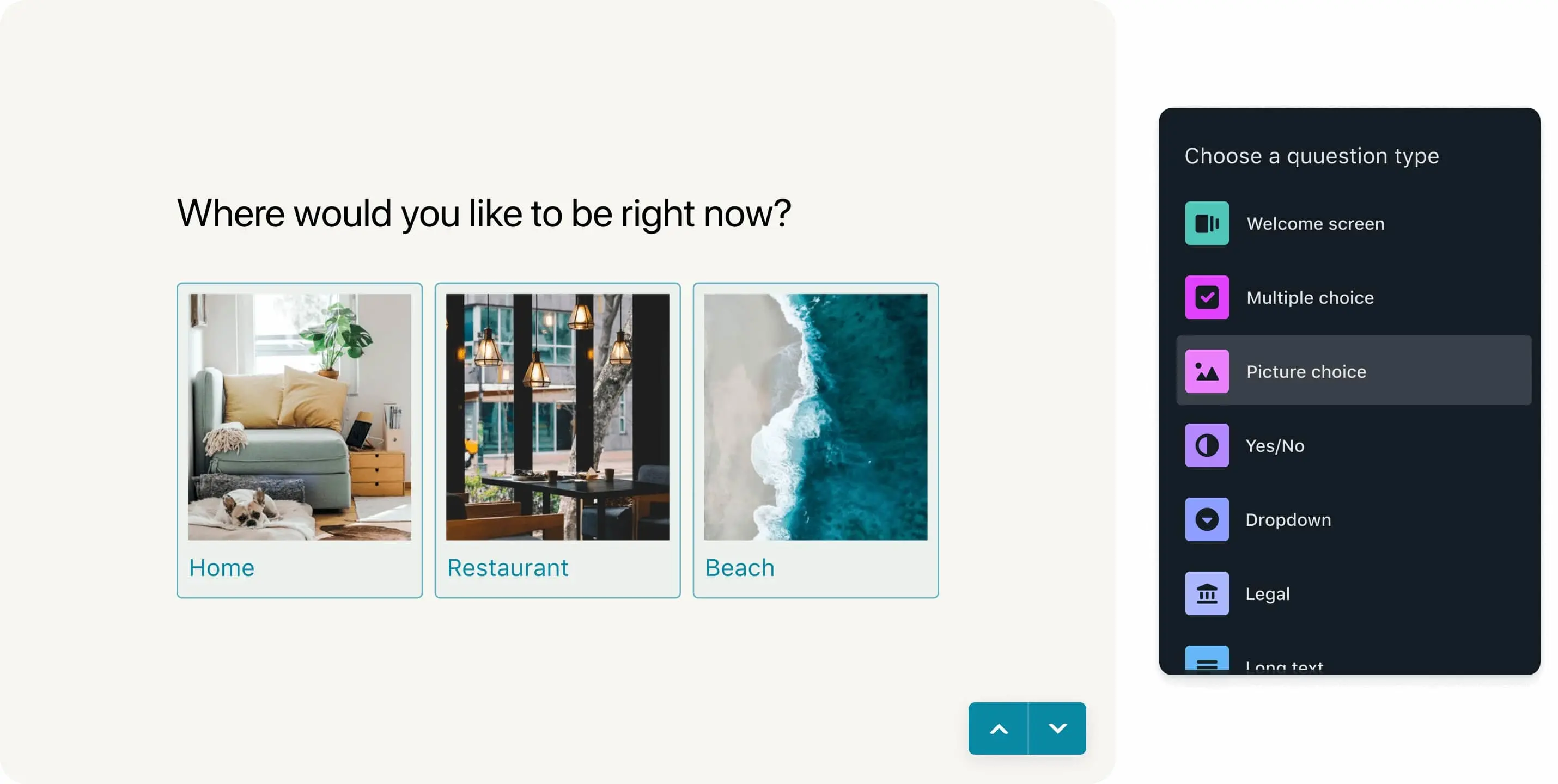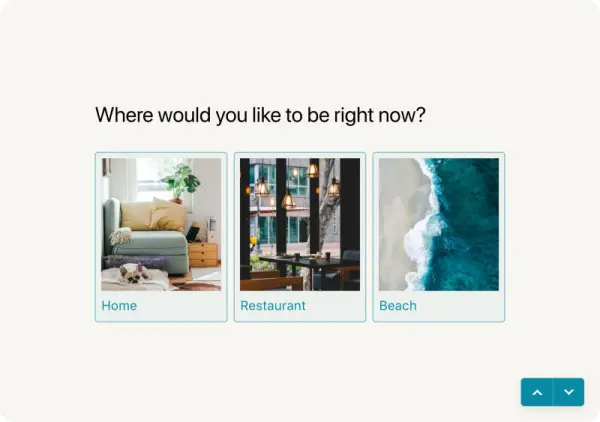Tips
Types of questions: Survey question types, examples, and tips
Learn about different types of questions to improve your survey completion. Get started today and craft better survey questions designed to keep people engaged.

Need some help writing survey questions? We' ve got you. Dive into our types of question examples and write kick-ass survey questions.
Types of survey questions
This is what you came for—the good stuff.
Here are the types of survey questions you should be using to get more survey responses:
- Open-ended questions
- Closed-ended questions
- Rating questions
- Likert scale questions
- Multiple-choice questions
- Picture choice questions
- Demographic questions
Open-ended questions
Open up a conversation with this question type. These are good types of questions to get more meaningful answers from, as people have the opportunity to give you more feedback through a text box. If you’re looking for a yes/no answer—you’ll need to use a closed-end question.
Open-ended question examples:
- What are you wearing today?
- How did you meet your best friend?
- What is it like to live in Barcelona?
Closed-ended questions
Some questions just need a one-word answer. Like yes. Or no. You can use them to get some quick bits of information, then go on to segment your survey accordingly.
Closed-ended questions examples:
- Did you order the chicken?
- Do you like learning German?
- Are you living in Australia?
Rating questions
Reach for the stars. Or the hearts. Or smiles. Send a rating question and find out how your survey-takers would rate something. It’s a super useful question to ask, as you can gauge peoples’ opinions across the board.
Rating questions examples:
- How would you rate our service out of 5?
- How many stars would you give our film?
- Please rate how valuable our training was today.
Likert scale questions
Likert scale questions are good survey questions for finding out what people think about certain things. Generally, they come in 5-, 7-, or 9-point scales, and you’ve probably filled one out before.
Likert scale questions examples:
- Do you agree that Channel 5 offers more comedy than Channel 6?
- How satisfied are you today with our customer service?
- Do you feel affected by the recent changes in the office?
Multiple-choice questions
Sending out a test or quiz? Multiple-choice questions are your friend. You can give a few answers and hide the real answer. Also, if you want to find out time periods or dates for an event, multiple-choice questions are the one. Plus, you can bundle them up nicely and neatly in a dropdown menu.
Multiple choice questions examples:
- Facebook was launched in… 2003 | 2004 | 2005 | 2006
- How many of our restaurants have you visited? 1 | 2 | 3 | 4+
- What is the capital of Scotland? Perth | Glasgow | Aberdeen | Edinburgh
Picture choice questions
A picture paints a thousand words. But in a survey? It does so much more. Ask a picture choice question and make your survey even more interactive. Tell a story, and show rather than tell.
Picture choice questions example:
Demographic questions
Demographic survey questions are a mix of different forms of questions. It’s up to you whether you want to use a dropdown here or an open-ended question with them.
Demographic question examples:
- How old are you?
- What’s your gender?
- Which industry do you work in?
Ask the right survey questions to get better results
We live in the information age, a time when data is a source of capital. Surveys have become one of the time-tested ways of gathering data. But even with 200+ years of published research and experience, people still fail to obtain helpful information from their surveys. Lucky for you, it doesn’t take much time to learn how to carry out a successful survey.
If you' re still stuck wondering what type of data you should be looking to collect, take a look at our guide to qualitative vs. quantitative research methods.
Best practices for different question types
Your objective is to get as many responses as you can so you can make the best decisions. But to do this, you need to follow a few basic “rules.”
Here’s an overview of the best practices for writing survey questions:
- Keep your language simple and specific: Unless you’re asking Ph.D. students about their opinions on string theory, there’s no need to include scientific or confusing language. Type like you’d talk.
- Avoid leading questions: “How was our amazing customer service team today?” Emm, not actually that great… Don’t plant opinions in peoples’ heads before they answer.
- Ask one question at a time: Avoid putting two questions into one—“How was the food and ambiance?” Separate questions to get better answers.
- Don’t make the survey excessively long: If your survey is over 20 questions long, pause to think. Some surveys are just, well, long. But if you can condense it, your audience will thank you.
- Show how much longer there is: That said, if it’s long, let people know how long. Tell people when they’re halfway through your survey.
- Make your surveys mobile-friendly: We’re always on the move. So make sure your survey can be completed from the subway as well as from the office.
- For big ideas, split them into multiple questions: If you’re asking for lots of opinions on one subject, try to split a huge question into several different questions, each covering a different angle. And consider using rating scale questions to see how people feel about different ideas.
- Use open-ended questions sparingly: An open-ended survey question is a brilliant response option for getting honest and actionable feedback. But people get bored of typing in long answers, so vary your answer options and don’t stuff in too many open-ended questions.
How to write great survey questions
Regardless of whether you’re creating a survey or a questionnaire, there is an art to designing effective types of questions. There are also several principles of survey design that' ll help you get the information you need from your customers.
Define the objective
Remember that the aim of conducting a survey isn’t just to get answers. We' re interested in what the answers will tell us about something else, which is why it’s crucial to define a clear purpose for every question you ask in a survey.
Before you start writing survey questions, create a list of objectives that outline the kind of information you’re trying to glean with each question. A plan for how you' ll use the data gathered from each response will help you ensure that the questions are targeted, relevant, and purposeful.
Example objective: Assess employee attitudes toward standing desks
Possible questions:
- In the past 12 months, have you used a standing desk?
- If yes: The standing desk improved my overall productivity (Agree—Neutral—Disagree)
- If no: I like the idea of testing a standing desk at work (Agree—Neutral—Disagree)
- Research has shown that standing desks result in fewer sick days and more productivity in the workplace. I believe the company should invest in standing desks for employees (Agree—Neutral—Disagree)
Understand that there are only two types of questions
While several articles expound various types of surveys, such as multiple-choice, Likert scales, open-ended, and so on, these actually refer to the types of responses. On the other hand, there are two survey question types: factual or objective questions and attitude or subjective questions.
Factual questions are aimed at gathering data to categorize and quantify people or events. Hypothetically, people’s responses to factual survey questions can be independently verified and have right and wrong answers. Examples of what objective survey questions cover are things like how often someone exercises, where they were born, and what their purchase habits are.
Attitude questions, on the other hand, measure perceptions, feelings, and judgments. These are things that can' t be observed or objectively assessed because they are based on what individuals think or experience.
Some examples of what subjective survey questions might cover include favorite brands, overall experience at a restaurant, or reasons for not voting for a certain candidate. With subjective survey questions, standardization is critical to ensure that people are interpreting and understanding the questions in the same way.
The objective of your overall survey will influence the type of questions you choose for your survey. The question type also has an impact on the response format (e.g., agree—disagree versus single-answer multiple-choice).
These two types of survey questions produce different kinds of data. Understanding the differences and how to treat each one will ensure you are producing meaningful information.
Ask questions people can answer
This seems obvious, yet there are surveys filled with questions that participants are unequipped to respond to.
There are three difficulties people have when answering survey questions:
- They don’t have the information. Most people can' t answer with any accuracy how many times they get up from their desk in a day, but they can give a vague indication (rarely, sometimes, often, never).
- They had the information but forgot it. Some people might know their exact income from two years ago, but most won’t. Avoid asking questions that rely on long-term memory or calculations.
- They have difficulty placing events in time. Participants may remember the last time they went to the movie theater, but they won’t remember whether it was six months ago or eight. If you must include questions that rely on long-term memory, use memory aids and association—for example, have them play out a scenario in their minds.
Imagine your objective is to learn whether water conservation warnings were effective.
Poor survey question: How much water did you use in your home last month?
Better question: In the last 30 days, how much water would you say your household used? (More than usual, less than usual, about the same as usual)
Reduce the possibility people will try to serve their own interests
Even in online surveys, people exhibit what social scientists call social desirability bias. This is the tendency for people to answer questions in socially acceptable ways. In some cases, it means overreporting good behaviors (“I get up from my desk every hour”) or underreporting perceived negative behaviors (“I drink alcohol once per week”).
Being aware of sensitive and taboo topics in the population you’re studying can help you anticipate these areas. To generate accurate responses, incorporate these strategies into the survey:
- Include an introductory statement: By explaining why you’re asking, you set up the question and help them understand the motivation behind it.
- Emphasize the anonymity of the survey: People who are confident their responses won’t be identified are more likely to respond honestly.
- Put sensitive and demographic questions at the end: Starting a survey with types of questions like age and income can put people off. Your first survey question should be interesting, light, and easy to answer. Once they’ve started, they’re more likely to finish—and answer more sensitive questions.
- Stress the importance of accuracy: Discourage dishonest answers by outlining the end goal of the survey. People who believe their answers will help are more likely to be truthful.
Survey questions should be unambiguous
Failing to write clear and specific questions can hinder your respondents’ ability to answer. The standard is that people should have a consistent understanding of what is being asked of them. If someone could interpret a question differently than you intended, the question could be improved. Avoid ambiguities. Don’t take for granted that people know what you mean in a survey question.
Poor survey question: In the past month, how many times have you visited a doctor?
There are two ambiguities in this question. First is the time frame: Does “in the past month” refer to the last 30 days or the most recent calendar month? The second is “doctor.” There' s a lot of room for interpretation—do nutritionists, spiritual healers, or psychologists count as doctors?
Better survey question: We' d like to understand how often you have visited a licensed medical professional, including dentists, psychologists, chiropractors, and nutritionists. In the past 30 days, how many times have you visited a medical professional?
If you need to define a term, be sure to put it first. Most people stop paying attention after the question has been asked.
Vague survey question: How would you rate your health?
The understanding of “health” isn’t consistent. Some people consider good health the absence of health conditions. Other people may be thinking about the extent to which they lead a healthy lifestyle.
Better survey question: Do you think you eat enough vegetables? (I eat plenty, I eat just enough, I could eat more, I don’t eat vegetables at all)
This question gets people to respond more directly to your interpretation of “health”: a healthy lifestyle. It may require asking more questions, but it' ll give you better data to work with.
Types of questions to avoid
Here are a few question types that should be avoided for the best survey data:
Loaded questions
Do you think there are more postgraduates (Master’s, Ph.D., MBA) because of the country’s weak economy?
The question also includes a false premise: The participant is required to agree that the economy is weak to answer. The question also imposes a causal relationship between the economy and postgraduate study that a person may not see. Loaded questions are inherently biased and push respondents into confirming a particular argument they may not agree with.
Double-barreled questions
Would you like to be rich and famous?
Double-barreled questions are difficult for people to answer. A person might like to be rich but not famous and would thus have trouble responding to this question. Additionally, you don’t know whether they are responding to both parts of the question or just one.
Biased questions
Do you agree that the president is doing a wonderful job on foreign policy?
Biased language that either triggers emotional responses or imposes your opinion can influence the results of your survey. Survey questions should be neutral, simple, and void of emotion.
Assumptive questions
Do you have extra money after paying bills that you invest?
This question assumes that the participant has extra money after paying bills. When a person reads a question they feel is irrelevant to them, it can lead to attrition from the survey. This is why Logic is useful—surveys should adapt to respondents’ answers so they can skip questions that don’t apply to them.
This question would be better asked in two parts: Do you have extra money after paying bills? (If yes: Do you invest the extra money you have after paying bills?)
Second-hand knowledge question
Does your community have a problem with crime?
Not only are “crime” and “problem” vague, it’s challenging for a layperson to report on something related to the community at large. The responses to the question wouldn’t be reliable. Stick to asking questions that cover people’s firsthand knowledge.
If you are trying to understand the prevalence of criminal acts, it would be better to ask: In the past 12 months, have you been the victim of a crime?
Hypothetical questions
If you received a $10,000 bonus at work, would you invest it?
People are terrible at predicting future behavior, particularly in situations they’ve never encountered. Behavior is deeply situational, so what a person might do upon receiving a bonus could depend on whether they had credit card debt, whether they needed to make an immediate purchase, the time of year, and so on.
Ask the right types of questions with Typeform
Understanding the different question types is crucial when it comes to surveys and customer feedback.
“The goal of writing a survey question is for every potential respondent to interpret it in the same way, be able to respond accurately, and be willing to answer,” explains Tammy Duggan-Herd, PhD, a psychology researcher-turned-marketer.
Focus on creating great survey questions, and you’ll get the answers and insights you need to achieve your goals.
Ready to conduct effective market research? Build beautifully designed surveys with the help of Typeform. With customizable survey templates, you can reach your audience faster and more effectively. Start asking the right types of questions today.





.png)
